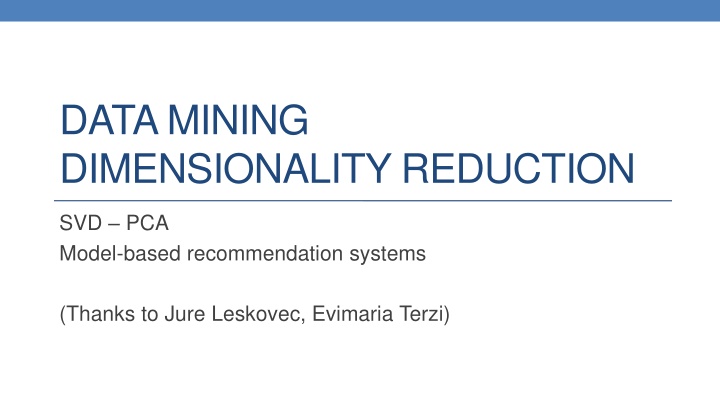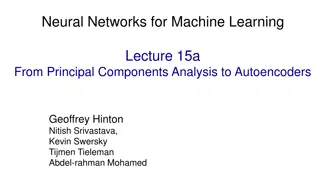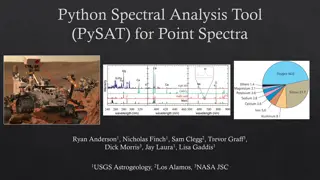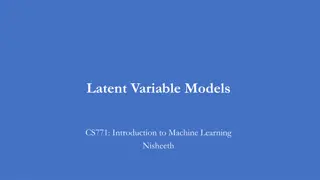
Data Mining Dimensionality Reduction Techniques Explained
Understand how the curse of dimensionality impacts data analysis, the importance of dimensionality reduction in managing high-dimensional data, and examples of reducing dimensionality for efficient data processing and analysis. Learn from real-world scenarios and expert recommendations.
Download Presentation

Please find below an Image/Link to download the presentation.
The content on the website is provided AS IS for your information and personal use only. It may not be sold, licensed, or shared on other websites without obtaining consent from the author. If you encounter any issues during the download, it is possible that the publisher has removed the file from their server.
You are allowed to download the files provided on this website for personal or commercial use, subject to the condition that they are used lawfully. All files are the property of their respective owners.
The content on the website is provided AS IS for your information and personal use only. It may not be sold, licensed, or shared on other websites without obtaining consent from the author.
E N D
Presentation Transcript
DATA MINING DIMENSIONALITY REDUCTION SVD PCA Model-based recommendation systems (Thanks to Jure Leskovec, Evimaria Terzi)
The curse of dimensionality Real data usually have thousands, or millions of dimensions E.g., web documents, where the dimensionality is the vocabulary of words Facebook graph, where the dimensionality is the number of users Huge number of dimensions causes problems Data becomes very sparse, some algorithms become meaningless (e.g., density-based clustering) The complexity of several algorithms depends on the dimensionality, and they become infeasible (e.g., nearest neighbor search).
Dimensionality Reduction Usually, the data can be described with fewer dimensions, without losing much of the information in the data. The data reside in a space of lower dimensionality
Example TID 1 2 3 4 5 6 7 8 9 10 11 12 13 14 15 A1 A2 A3 A4 A5 A6 A7 A8 A9 A10 B1 B2 B3 B4 B5 B6 B7 B8 B9 B10 C1 C2 C3 C4 C5 C6 C7 C8 C9 C10 1 1 1 1 1 1 1 1 1 1 0 0 0 0 0 1 1 1 1 1 1 1 1 1 1 0 0 0 0 0 1 1 1 1 1 1 1 1 1 1 0 0 0 0 0 1 1 1 1 1 1 1 1 1 1 0 0 0 0 0 1 1 1 1 1 1 1 1 1 1 0 0 0 0 0 0 0 0 0 0 0 0 0 0 0 1 1 1 1 1 0 0 0 0 0 0 0 0 0 0 1 1 1 1 1 0 0 0 0 0 0 0 0 0 0 1 1 1 1 1 0 0 0 0 0 0 0 0 0 0 1 1 1 1 1 0 0 0 0 0 0 0 0 0 0 1 1 1 1 1 0 0 0 0 0 0 0 0 0 0 0 0 0 0 0 0 0 0 0 0 0 0 0 0 0 0 0 0 0 0 0 0 0 0 0 0 0 0 0 0 0 0 0 0 0 0 0 0 0 0 0 0 0 0 0 0 0 0 0 0 0 0 0 0 0 0 0 0 0 0 0 0 0 0 0 0 0 0 0 0 1 1 1 1 1 0 0 0 0 0 0 0 0 0 0 1 1 1 1 1 0 0 0 0 0 0 0 0 0 0 1 1 1 1 1 0 0 0 0 0 0 0 0 0 0 1 1 1 1 1 0 0 0 0 0 0 0 0 0 0 1 1 1 1 1 0 0 0 0 0 0 0 0 0 0 0 0 0 0 0 1 1 1 1 1 0 0 0 0 0 0 0 0 0 0 1 1 1 1 1 0 0 0 0 0 0 0 0 0 0 1 1 1 1 1 0 0 0 0 0 0 0 0 0 0 1 1 1 1 1 0 0 0 0 0 0 0 0 0 0 1 1 1 1 1 0 0 0 0 0 0 0 0 0 0 1 1 1 1 1 0 0 0 0 0 0 0 0 0 0 1 1 1 1 1 0 0 0 0 0 0 0 0 0 0 1 1 1 1 1 0 0 0 0 0 0 0 0 0 0 1 1 1 1 1 0 0 0 0 0 0 0 0 0 0 1 1 1 1 1 In this data matrix the dimension is essentially 3 There are three types of products and three types of users
J. Leskovec, A. Rajaraman, J. Ullman: Mining of Massive Datasets, http://www.mmds.org 5 Example Cloud of points 3D space: Think of point positions as a matrix: A B C A 1 row per point: We can rewrite coordinates more efficiently! Old basis vectors: [1 0 0] [0 1 0] [0 0 1] New basis vectors: [1 2 1] [-2 -3 1] Then A has new coordinates: [1 0]. B: [0 1], C: [1 -1] Notice: We reduced the number of coordinates!
Dimensionality Reduction Find the true dimension of the data In reality, things are never as clear and simple as in this example, but we can still reduce the dimension. Essentially, we assume that some of the data is useful signal, and some data is noise, and that we can approximate the useful part with a lower dimensionality space. Dimensionality reduction does not just reduce the amount of data, it often brings out the useful part of the data
J. Leskovec, A. Rajaraman, J. Ullman: Mining of Massive Datasets, http://www.mmds.org 7 Dimensionality Reduction Rather than representing every point with 2 coordinates we represent each point with 1 coordinate (corresponding to the position of the point on the red line). By doing this we incur a bit of error as the points do not exactly lie on the line We assume that the line has the useful information, while the errors are noise Goal of dimensionality reduction is to discover the axis of data!
J. Leskovec, A. Rajaraman, J. Ullman: Mining of Massive Datasets, http://www.mmds.org 8 Why Reduce Dimensions? Discover hidden correlations/topics E.g., in documents, words that occur commonly together Remove redundant and noisy features E.g., in documents, not all words are useful Interpretation and visualization Easier storage and processing of the data
Data in the form of a matrix We are given ? objects and ? attributes describing the objects. Each object has ? numeric values describing it. We will represent the data as a ? ? real matrix A. We can now use tools from linear algebra to process the data matrix Our goal is to produce a new ? ? matrix B such that It preserves as much of the information in the original matrix A as possible It reveals something about the structure of the data in A
Example: Document matrices d terms (e.g., theorem, proof, etc.) n documents Aij= frequency of the j-th term in the i-th document Find subsets of terms that bring documents together
Example: Recommendation systems d movies n customers Aij= rating of j-th product by the i-th customer Find subsets of movies that capture the behavior or the customers
Linear algebra We assume that vectors are column vectors. We use ?? for the transpose of vector ? (row vector) ? Dot product: ??? (1 ?,? 1 1 1) The dot product is the projection of vector ? on ? (and of ? on ?) 4 1 2 = 12 1,2,3 ? ??? = ? ? cos(?,?) If ||?|| = 1 (unit vector) then ??? is the projection length of ? on ? If ? = ? = 1 then ??? is the cosine similarity of ? and ? 4 = 0 : orthogonal vectors 1,2,3 1 2 Orthonormal vectors: two unit vectors that are orthogonal
Matrices An n m matrix A is a collection of n row vectors and m column vectors ? ?1 ?2 ?3 | | | ? ?1 | ?2 | ?3 | ? = ? = ? Matrix-vector multiplication Right multiplication ??: projection of ? onto the row vectors of ?, projection of row vectors of ? onto ?. Left-multiplication ???: projection of ? onto the column vectors of ?, projection of column vectors of ? onto ? Example: ? ?? ?? ?? ?1 ?2 ?3 ?1 ?2 ?3 | ? | ? ?? = = ? | | | ??? = ?? = ???1,???2,???3 ?1 | ?2 | ?3 | 1 2 3 1 0 0 1 0 0 =1 2
Change of basis By default, a vector is expressed in the axis-aligned basis. For example, for vector [-1,2] we have: 1 2 1 With a projection we can change the basis over which the vector is expressed. = 11 0+ 20 2 2 2 2 2 2 2 3 2 2 2 2 1 2 = 2 The rows of the matrix are the new basis vectors
Row and Column space Row space of A: The set of vectors that can be written as a linear combination of the rows of A All vectors of the form ? = ??? the coordinates of u are the coefficients of the linear combination ?1?11 + ?2?21 + + ????1 ? ?1?1? + ?2?2? + + ????? ?1?1? + ?2?2? + + ????? ?1?1 + ?2?2 + + ???? ?11 ?1? ?1? ?21 ?2? ?2? ??1 ??? ??? ? = ?1 ?? ?? = ? Column space of A: The set of vectors that can be written as a linear combination of the columns of A All vectors of the form ? = ??. the coordinates of u are the coefficients of the linear combination
Rank Rank of A: the number of linearly independent row (or column) vectors These vectors define a basis for the row (or column) space of A All vectors in the row (column) space are linear combinations of the basis vectors Example 1 2 1 1 0 Matrix ? = has rank ? = ? 2 3 3 5 Why? The first two rows are linearly independent, so the rank is at least 2, but all three rows are linearly dependent (the first is equal to the sum of the second and third) so the rank must be less than 3.
Rank-1 matrices In a rank-1 matrix, all columns (or rows) are multiples of the same column (or row) vector 1 2 3 All rows are multiples of ??= [1,2, 1] 2 4 6 1 2 3 ? = 1 2 3 All columns are multiples of ? =
Rank-1 matrices A rank-1 matrix is the result of the outer product of two vectors Outer product: ??? (? 1 ,1 ? ? ?) ?1?? ???? ???? ?1 ?? ?? ?1?1 ???1 ???1 ?1?? ???? ???? ???= ?1 ?? ?? = The resulting ? ? matrix has rank 1: all rows (or columns) are linearly dependent ? = ??? ? = 1 2 3 2 4 6 1 2 3 1 2 3 , ? = , ??= [1,2, 1]
Eigenvectors (Right) Eigenvector of matrix ?: a vector ? such that ?? = ?? ?: eigenvalue of eigenvector ? A symmetric matrix ? of rank ?, has ? orthonormal eigenvectors ?1,?2, ,?? with eigenvalues ?1,?2, ,??. Eigenvectors define an orthonormal basis for the column and row spaces of ? We can write: | | | ?1 | ?2 | ?? | ? = ? = ? ?? ?+ ?2?2?2 ?+ + ?????? ? ? = ?1?1?1 ?1 0 ?2 = 0 ?? Any vector ?? (resp. ???) can be written as a linear combination of the vectors ?1,?2, ,?? (resp. ?1 ?) ?,?2 ?, ,??
SINGULAR VALUE DECOMPOSITION (SVD)
Singular Value Decomposition (SVD) ? ?1 ?1 ?2 ??? 0 ? ?2 ? = ? ??= ?1,?2, ,?? 0 [n m] = [n r] [r r] [r m] r: rank of matrix A ?? ?1, ?2 ??: singular values of matrix ? SVD can be computed for any matrix (not necessarily symmetric or square) ?1,?2, ,??: left singular vectors of ? ?1,?2, ,??: right singular vectors of ? ?+ + ??????? ?+ ?2?2?2 ? = ?1?1?1
Singular Value Decomposition The left singular vectors ? are an orthonormal basis for the column space of ?. The right singular vectors ? are an orthonormal basis for the row space of ?. If ? has rank ?, then ? can be written as the sum of ? rank-1 matrices There are ? linear components/trends (axes) in ?. Linear component: vector ?along which the row vectors of ? tend to be aligned Strength of the i-th linear trend: ||???|| = ?? Property of SVD: ?1= arg max ?: ? =1| ?? |
Symmetric matrices Special case: ? is symmetric positive definite matrix ?+ ?2?2?2 ?+ + ?????? ? ? = ?1?1?1 ?1 ?2 ?? 0: Eigenvalues of ? are also the singular values ?1,?2, ,??: Eigenvectors of ? are also the left and right singular vectors
Singular Values and Eigenvalues Singular Value Decomposition ? = ? ?? The left singular vectors of ? are also the eigenvectors of the (symmetric) matrix ??? ???= ? 2?? The right singular vectors of ? are also the eigenvectors of the (symmetric) matrix ??? ??? = ? 2?? The singular values of matrix ? are also the square roots of eigenvalues of ??? and ??? ????? = ?????= ?? 2
SVD properties Singular Value Decomposition has three useful properties that we will study now: It provides the important (principal) directions (dimensions) in the data Principal Component Analysis It provides the best low rank approximation for our matrix It minimizes the reconstruction error (squared distance between real data points and their estimates)
Principal Component Analysis Goal: reduce the dimensionality while preserving the information in the data . In the new space we want to: Maximize the amount of information Minimize redundancy remove the redundant dimensions Minimize the noise in the data.
Variability Information in the data: variability in the data We measure variability using the covariance matrix. Sample variance for variable X: 2=1 ?? ?? =1 ?? ?? ?? ? ?? ?? ? ?? ? ? Sample covariance of variables X and Y 2=1 (?? ??) (?? ??) =1 ?? ?? ??? ? ? ?? ? ? 2 means high information in dimension (attribute) X High variance ?? 2 ??????? ?????? We want to maximize the signal-to-noise ratio 2 2 means high correlation between attributes X,Y, and thus high High co-variance ??? redundancy. Ideally, we want ??? 2= 0 for all pairs X,Y
Example In the data below the data are essentially one-dimensional, but what is the axis we should use? The direction in which the variance is maximized. The variance along the direction orthogonal to the main direction is small and captures the noise in the data 2 ?????? 2 ???????
Example Which direction is best to project? Note that in the case of blue and green directions we have points that are far falling on each other. The red maximizes the variance, which gives more information
Covariance matrix We are given the data matrix ?, with ? rows and ? columns, where the rows correspond to data samples over a set of features defined by the columns. Remove the mean of each column from the column vectors to get the centered matrix ? The matrix C = ?? ? is proportional to the covariance matrix of the column vectors of ?. We want to change the basis of the data so that the matrix becomes diagonal All the values are in the diagonal and the off-diagonal entries are zero Covariances now become zero, so there is no redundancy
PCA: Principal Component Analysis We will project the rows of matrix ? onto a new set of attributes (dimensions) such that: Each attribute captures the most remaining variance in the data, while orthogonal to the existing attributes The first attribute should capture the most variance in the data The attributes have zero covariance to each other (they are orthogonal) For matrix ?, the variance of the rows of ? when projected to vector ? is proportional to ?2= The first right singular vector of ? maximizes ?2! 2 ??
PCA and SVD PCA is a special case of SVD on the centered matrix. After projecting the centered matrix ? to the singular vectors in ? we have that the covariance matrix of the new dataset ?? is: ??? We have achieved to make the matrix diagonal! ?? = Dimensionality reduction: Don t keep all the singular vectors in ? just the ? first ones.
PCA Input:2-d dimensional points 5 Output: 2nd (right) singular vector 1st (right) singular vector: direction of maximal variance, 4 2nd (right) singular vector: direction of maximal variance, after removing the projection of the data along the first singular vector. 3 1st (right) singular vector 2 4.0 4.5 5.0 5.5 6.0
Singular values 5 2nd (right) singular vector 1: measures data variance along the first singular vector. 4 2: measures how much of the data variance is explained by the second singular vector. 3 1 1st (right) singular vector 2 4.0 4.5 5.0 5.5 6.0
Singular values tell us something about the variance The variance in the direction of the ?-th principal component is given by the corresponding singular value ??2 Singular values can be used to estimate how many components to keep Rule of thumb: keep enough to explain 85% of the variation: k = n 2 j 1 j . 0 85 = j 2 j 1
SVD and Rank-kapproximations A = U VT features sig. significant significant noise noise = noise objects We keep the k most important singular vectors The matrix ?? ??? The idea is that this is the part that has the useful information and noise is removed This is also the best rank-k approximation (closest to the original A) ? is a rank-k approximation of A
Rank-k approximations (Ak) n x d n x k k x k k x d ?? orthogonal matrix containing the top k left singular vectors of A. ??: orthogonal matrix containing the top k right singular vectors of A. ??: diagonal matrix containing the top k singular values of A ??is a rank-k approximation of? ??is the best approximation of?
SVD as an optimization The rank-k approximation matrix ?? produced by the top-k singular vectors of A minimizes the Frobenious norm of the difference with the matrix A 2 ??= arg ?:???? ? =?? ?? min 2 2= ? ?? ??? ??? ?,? Explanation: The (?,?) cell in ??is close on average with the ?,? cell of ?
What does this mean? We can project the row (and column) vectors of the matrix A into a ?-dimensional space and preserve most of the information (Ideally) The ?? approximation of matrix A, contains all the useful information, and what is discarded is noise (Ideally) The ? dimensions reveal latent features/aspects/topics of the term (document) space.
LATENT FACTOR MODELS AND RECOMMENDATION SYSTEMS
Latent factor model Rows (columns) are linear combinations of ? latent factors E.g., in our extreme document example there are two factors Some noise is added to this rank-k matrix resulting in higher rank SVD retrieves the latent factors (hopefully).
An (extreme) example User-Movie matrix Blue and Red rows (colums) are linearly dependent A = There are two prototype users (vectors of movies): blue and red To describe the data is enough to describe the two prototypes, and the projection weights for each row A is a rank-2 matrix ? ?1 ?2 ? = ?1,?2 ?
J. Leskovec, A. Rajaraman, J. Ullman: Mining of Massive Datasets, http://www.mmds.org 47 SVD Example: Users-to-Movies A = U VT - example: Users to Movies Casablanca Serenity Amelie Matrix 1 1 1 0 0 3 3 3 0 0 4 4 4 0 0 5 5 5 0 0 0 0 0 4 4 0 0 0 5 5 0 0 0 2 2 Alien n SciFi V VT T = m Romance U U Concepts AKA Latent dimensions AKA Latent factors
J. Leskovec, A. Rajaraman, J. Ullman: Mining of Massive Datasets, http://www.mmds.org 48 SVD Example: Users-to-Movies A = U VT - example: Users to Movies Casablanca SciFi-concept Romance-concept Serenity Amelie Matrix 1 1 1 0 0 3 3 3 0 0 4 4 4 0 0 5 5 5 0 0 0 0 0 4 4 0 0 0 5 5 0 0 0 2 2 Alien 0.14 0.00 0.42 0.00 0.56 0.00 0.70 0.00 0.00 0.60 0.00 0.75 0.00 0.30 SciFi 12.4 0 0 9.5 = x x Romance 0.58 0.58 0.58 0.00 0.00 0.00 0.00 0.00 0.71 0.71
J. Leskovec, A. Rajaraman, J. Ullman: Mining of Massive Datasets, http://www.mmds.org 49 SVD Example: Users-to-Movies A = U VT - example: Users to Movies Casablanca SciFi-concept Romance-concept Serenity Amelie Matrix 1 1 1 0 0 3 3 3 0 0 4 4 4 0 0 5 5 5 0 0 0 0 0 4 4 0 0 0 5 5 0 0 0 2 2 Alien Uis user-to-concept similarity (or importance) matrix 0.14 0.00 0.42 0.00 0.56 0.00 0.70 0.00 0.00 0.60 0.00 0.75 0.00 0.30 SciFi 12.4 0 0 9.5 = x x Romance 0.58 0.58 0.58 0.00 0.00 0.00 0.00 0.00 0.71 0.71
J. Leskovec, A. Rajaraman, J. Ullman: Mining of Massive Datasets, http://www.mmds.org 50 SVD Example: Users-to-Movies A = U VT - example: Users to Movies Casablanca SciFi-concept Romance-concept Serenity Amelie Matrix 1 1 1 0 0 3 3 3 0 0 4 4 4 0 0 5 5 5 0 0 0 0 0 4 4 0 0 0 5 5 0 0 0 2 2 Alien Vis movie to concept similarity (or importance) matrix 0.14 0.00 0.42 0.00 0.56 0.00 0.70 0.00 0.00 0.60 0.00 0.75 0.00 0.30 SciFi 12.4 0 0 9.5 = x x Romance 0.58 0.58 0.58 0.00 0.00 0.00 0.00 0.00 0.71 0.71
J. Leskovec, A. Rajaraman, J. Ullman: Mining of Massive Datasets, http://www.mmds.org 51 SVD Example: Users-to-Movies A = U VT - example: Users to Movies Casablanca SciFi-concept Romance-concept Serenity Amelie Matrix 1 1 1 0 0 3 3 3 0 0 4 4 4 0 0 5 5 5 0 0 0 0 0 4 4 0 0 0 5 5 0 0 0 2 2 Alien is the concept strength matrix 0.14 0.00 0.42 0.00 0.56 0.00 0.70 0.00 0.00 0.60 0.00 0.75 0.00 0.30 SciFi 12.4 0 0 9.5 = x x Romance 0.58 0.58 0.58 0.00 0.00 0.00 0.00 0.00 0.71 0.71
J. Leskovec, A. Rajaraman, J. Ullman: Mining of Massive Datasets, http://www.mmds.org 52 SVD Example: Users-to-Movies A = U VT - example: Users to Movies Movie 2 Casablanca Serenity Amelie 1st singular vector Matrix 1 1 1 0 0 3 3 3 0 0 4 4 4 0 0 5 5 5 0 0 0 0 0 4 4 0 0 0 5 5 0 0 0 2 2 Alien 0.14 0.00 0.42 0.00 0.56 0.00 0.70 0.00 0.00 0.60 0.00 0.75 0.00 0.30 Movie 1 SciFi 12.4 0 0 9.5 = x x is the spread (variance) matrix Romance 0.58 0.58 0.58 0.00 0.00 0.00 0.00 0.00 0.71 0.71






















